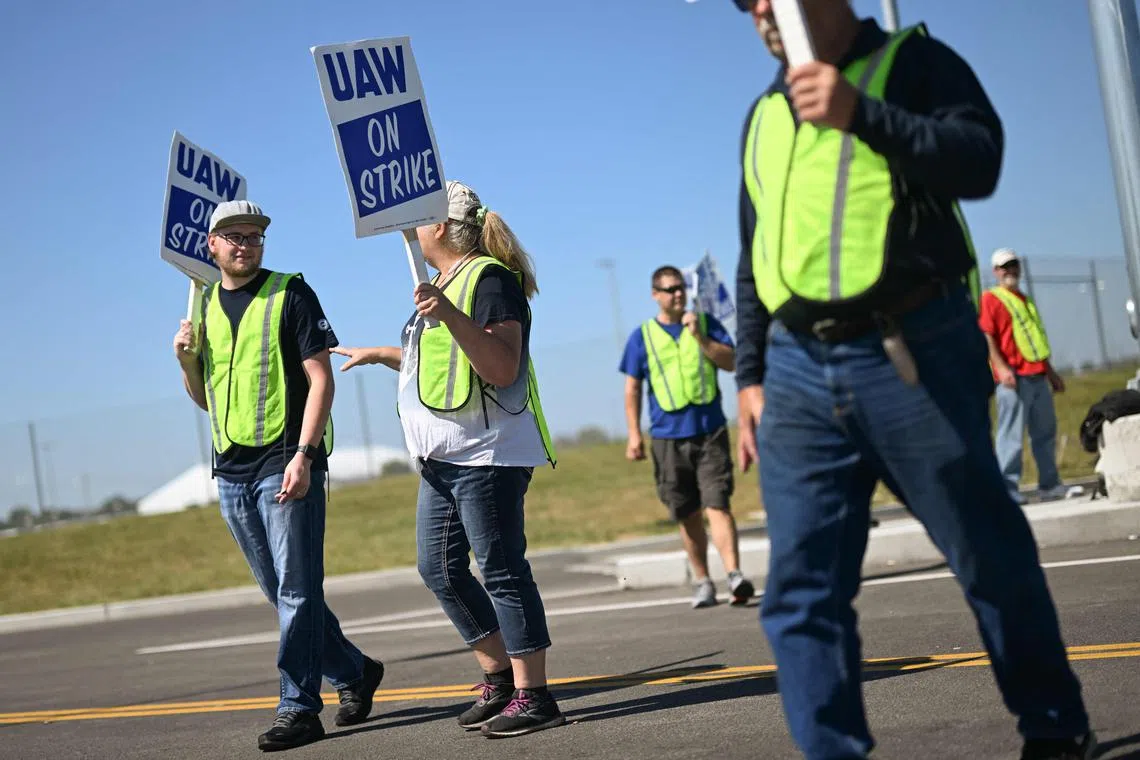US auto workers' strike: What are the implications?
Sign up now: Get ST's newsletters delivered to your inbox

Unionized auto workers in the United States have launched a strike at three factories in a historic walkout after failing to reach a deal with Detroit’s “Big Three” auto makers.
PHOTO: AFP
Follow topic:
NEW YORK - Unionized auto workers in the United States have launched a strike at three factories in a historic walkout after failing to reach a deal
With the automotive sector being a major part of the world’s biggest economy, here is a summary of the implications.
Millions of jobs
The automotive ecosystem drives some US$1 trillion (S$1.4 trillion) into the US economy each year, nearly 5 per cent of gross domestic product, according to the Alliance for Automotive Innovation.
The group, which represents the auto industry, said in a 2022 report that the sector supports 9.6 million jobs.
In its industry report, the alliance noted that “more than $220 billion in federal and state revenue is generated annually by the manufacture, sale and maintenance of autos”.
And the sector is benefiting from the rapid growth of electric carmaker Tesla, which delivered 1.3 million EVs in 2022.
‘The Big Three’
General Motors (GM), Ford and Stellantis are dubbed the “Big Three” of US carmakers and have production facilities in the Detroit, Michigan, area.
They operate 60 per cent of the country’s assembly plants, according to the American Automotive Policy Council, which represents the three companies.
The United Auto Workers strike involves only 12,700 of 150,000 members represented by the union, but the action could broaden in the coming days.
A major risk in the event of a prolonged strike is “degradation of the supply chain and the financial health of the parts and equipment suppliers”, said CFRA analyst Garrett Nelson.
Mr Michael Pearce of Oxford Economics added in a note that “a total walkout would reduce motor vehicle output by over 30 per cent”.
Scale of operations
GM employs over 92,000 people in the United States according to its website, and delivered 2.3 million vehicles in the country in 2022 under the Chevrolet, Buick, GMC and Cadillac brands.
In 2022, its revenue rose by 23 per cent to US$157 billion, while its net income came in at US$9.9 billion.
Ford – founded 120 years ago – hires some 177,000 people, including about 86,000 in the United States.
It manufactures the Ford brand including the F-150 pickup truck, which the company calls “America’s truck” because it is assembled entirely in the United States and has been the country’s most popular vehicle for more than four decades.
Meanwhile US-European auto giant Stellantis, whose brands include Jeep, Chrysler and Peugeot, has 264,000 staff globally.
In 2022, it posted profits of €16.8 billion (S$24.4 billion).
Foreign automakers
Apart from US carmakers, international automakers produced 4.4 million vehicles in the United States in 2022, according to Autos Drive America.
Their production volume has ballooned by over 85 per cent in more than two decades.
And this has brought their share of US production from 1 per cent in 1979 to 45 per cent in 2022.
Among global brands that have plants in America are BMW, Kia, Honda, Lexus, Volkswagen and Hyundai.
In 2022, international auto makers directly employed 156,000 US employees. AFP

